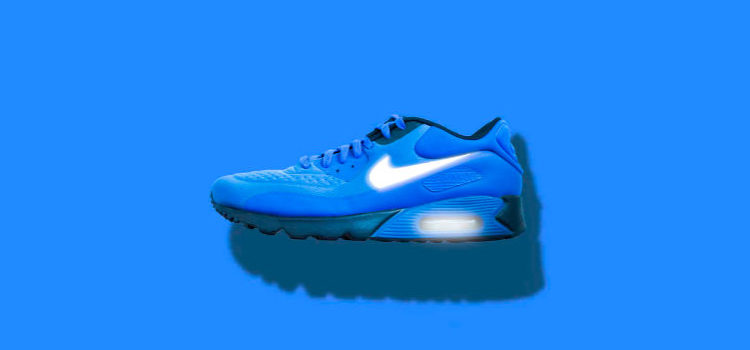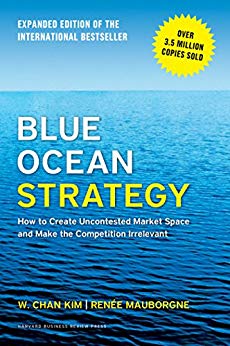

This article is an excerpt from the Shortform summary of "Blue Ocean Strategy" by W. Chan Kim and Renee Mauborgne. Shortform has the world's best summaries of books you should be reading.
Like this article? Sign up for a free trial here .
How do you chart a blue ocean strategy graph? How do you determine whether your product is unique enough to classify as a “blue ocean”?
Kim and Mauborgne present a graphic tool to help you visualize how your product (and the strategy behind it) differs from others in the market. If your curve has a completely different shape from other curves, this implies a unique combination of value, consistent with the blue ocean strategy.
Here is how to use the blue ocean strategy chart to gauge where your business stands against competitors.
The Blue Ocean Strategy Canvas
The blue ocean strategy graph allows you to see at a glance how similar or how different your product’s offerings are from your rivals’. It consists of a two-dimensional line graph:
- The horizontal axis lists the characteristics of competition, that is, the attributes of your product and its alternatives that customers consider when making a buying decision. The authors emphasize that it’s important to list only characteristics that customers actually care about.
- The vertical axis represents the emphasis a company places on each characteristic—a higher score indicates a company offers more of that characteristic.
For each product, service, or company that you wish to compare, plot the value of each characteristic on the graph as a point. Then connect the points to produce a strategy curve.
For example:
Kim and Mauborgne have developed the blue ocean strategy graph to help you get an idea of how your product offerings differ from your competitors’. If your curve has a completely different shape from other curves, this implies a unique combination of value, consistent with the blue ocean strategy.
Shortform Commentary: Customer Priorities on the Strategy Chart
Kim and Mauborgne emphasize that you should only include characteristics that your customers actually care about on a blue ocean strategy chart. What they don’t mention is that sometimes, customers care more about certain things than others, even when they take them all into consideration. There are a couple of ways you could enhance your blue ocean strategy chart to reflect the priorities that customers put on different characteristics.
One way would be to sort the characteristics from most important to least important. As you interview customers to figure out what characteristics they care about, ask them which characteristics are more important to them than others. Once you determine how your customers prioritize different product characteristics, put the most important one at the left edge of the chart, followed by the others in order of importance from left to right. If the example chart above had been organized this way, it would show that customers care most about price and second-most about reliability, while training is the least important characteristic that they care about.
Another way would be to scale the height of each characteristic on the chart according to how important it is. In this case, the first step would be to talk to your customers and find out how much they value each of the different characteristics of the product. Then, based on their answers, assign a weight factor to each characteristic. The weight factor is a number that indicates how important that characteristic is. When you plot the value that a particular product provides on your chart, multiply the value by the weight factor for each characteristic. The chart below shows the original product strategy curve, the weight factors, and the resulting weighted strategy curve, to illustrate how multiplying by the weight factors visually exaggerates the characteristics that are more important to customers.
However, for the purpose of exploring your strategy, you would only actually plot the weighted strategy curve for each product that you want to compare. Since you multiply each product by the same weight factors, the curves still allow you to compare different products and strategies, but they would make the customers’ priorities stand out visually.
Revealing Red Oceans
Kim and Mauborgne note that, if the curve of your product closely follows that of another, then the two products follow the same value strategy. Similarly, if your curve is either lower or higher than the other but has the same overall shape, then one product is just a premium or budget version of the other. (In our example above, Product X is a premium version of Product Y.) Kim and Mauborgne warn that in either case, this implies red ocean strategy, with direct competition between the products.
| Troubleshooting Red-Ocean Strategy Curves What should you do if your blue ocean strategy chart indicates your new product is a red ocean concept? According to Al Ries and Jack Trout, sometimes it’s not even necessary to change your product in order to give it unique value. As we noted, Kim and Mauborgne emphasize listing only characteristics that your customers would actually care about, not just trivial characteristics that superficially differentiate your product. However, maybe customers would care about some of those differences if you showed them why they’re important. For example, perhaps your product is just a little smaller than any of the others on the market, and that makes it easier for smaller people, such as children, to use. Until now, no one cared about this difference because you were competing for adult customers. But if you market your product as the only offering of its kind for children, then suddenly it has unique value and no direct competition. In this case, you’ve created a new characteristic (child friendliness) on the blue ocean strategy chart without changing the product itself at all. (As we’ll discuss in the next section, you’ve also reached out to potential customers—in this case, children.) |
The blue ocean strategy chart can also show you how targeted your offering is. According to Kim and Mauborgne, it’s very unlikely that all customers care equally about all the characteristics. Thus, if your strategy curve is nearly flat, it implies that you’re trying to appeal equally to everyone. They warn that in this case, your product will not be as compelling to anyone as a more focused offering would be. In our example above, Product Z is falling into this trap.
(Shortform note: Ries and Trout likewise observe that appealing to a specific audience is crucial for successfully marketing a product, and they add the nuance that maintaining this focus can be psychologically difficult because it’s counterintuitive: To target a specific market sector, you have to give up targeting other sectors, so you’re targeting fewer customers in order to make more sales. This counterintuitiveness makes it easy to make the mistake of trying to be everything to everyone.)
———End of Preview———

Like what you just read? Read the rest of the world's best summary of "Blue Ocean Strategy" at Shortform . Learn the book's critical concepts in 20 minutes or less .
Here's what you'll find in our full Blue Ocean Strategy summary :
- What blue oceans are, and how you create one for your business
- Why some businesses succeed in creating blue oceans, and why others fail
- The red ocean traps you have to avoid if you want business growth






